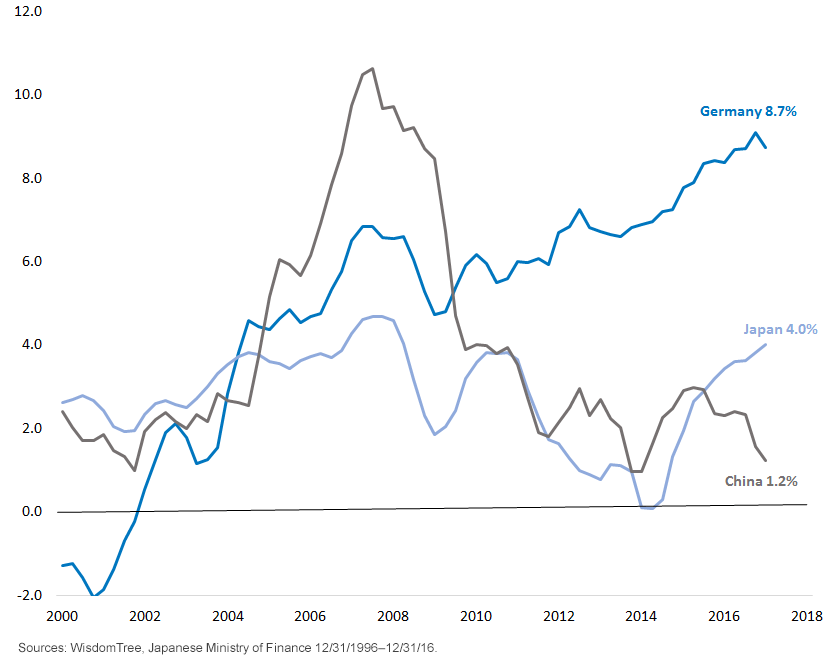“Team Trump” Asia Pivot: U.S.–China–Japan Dynamics Move into Focus


The coming two weeks are poised to go down as the first real insight into “Team Trump’s” global economic leadership skills. At stake are the U.S.–China–Japan trade and investment dynamics, i.e., the future of economic relations in the Asia Pacific region, the world’s most dynamic. Can the reality of “America First” go hand in hand with shared Asian prosperity? The key agenda items are as follows and suggest that we’ll have some concrete answers by around April 23–25. In my view, these events must be taken together, and amid high uncertainty, they have the potential to become a positive catalyst for “risk-on” for global assets in general, and for Japanese risk assets in particular:
- April 6–7: U.S. president Trump meets Chinese president Xi Jinping
- April 14: U.S. Treasury publishes report on currency manipulation, the first under the new regime
- Week of April 17: U.S. vice-president Mike Pence and commerce secretary Wilbur Ross go to Tokyo for the first U.S.–Japan economic, trade and finance framework talk
The Trump administration has shown great ambition to rewrite the rules of global trade and investment. Here, the U.S.–Japan relationship is a clear first mover: Prime Minister Abe already met President Trump twice; the April 17 talks mark a shift from the abstract and toward concrete deals—trade rules, investment initiatives, specific infrastructure projects, joint-ventures.
Ambitions run high in Tokyo and Washington; Trump’s America and Abe’s Japan aim to create the first bilateral “Free and Fair Trade & Investment Agreement,” a possible blueprint for other countries’ dealings with Trump’s America. Both Vice-President Pence and Commerce Secretary Ross have extensive experience and networks in Japan. They also negotiate from a position of strength—Team Abe is keen to make fast and concrete progress. The better the U.S.–Japan economic relationship, the better U.S.–Japan security and defense relations, and the higher Abe’s popularity.
In contrast, the U.S.–China relationship is off to a more complex start. Both sides have lowered expectations consistently by stressing their differences. The key question will be whether they can agree to set up a similar working level group for economic and trade issues similar to the one between Japan and the U.S. A commitment to continued U.S.–China dialogue is a minimum condition for global risk takers. The lack of commitment to a new framework of bilateral talks would trigger “risk-off,” in my view. I am hopeful pragmatism prevails.
Currency Manipulator—Does the White House Coordinate with the Treasury?
Meanwhile, the Treasury will publish its report on global currency manipulation on April 14, the first one drafted by the new regime. Here, Japan’s position is technically a bit weaker than China’s. It will be interesting to see whether coordination between the White House and the Treasury could actually work in favor of Japan and/or against China.
Currently, three criteria determine currency manipulation, as far as the Treasury is concerned:
- A bilateral trade surplus larger than US$20 billion
- A current account surplus in excess of 3% of gross domestic product Gross Domestic Product (GDP)
- Persistent FX intervention
Both Japan and China exceed the bilateral deficit threshold: in 2016, the U.S. ran a US$347 billion trade deficit with China, and a US$69 billion deficit with Japan.1
On the current account criterion, Japan showed a surplus of 4% of GDP (moving average of the final three quarters of 2016), while China’s surplus stood at 1.2% of GDP. So technically, that’s a hit on Japan. However, there is room for interpretation: Japan’s current account surplus is primarily due to a very large factor income surplus that stood at 3.1% of GDP in October–December 2016, while the trade surplus was only 1.2% of GDP. In other words, the current account is in a deficit because of Japan’s large overseas investment position that generates good returns from holding U.S. treasuries and creating U.S. jobs in Japanese-owned U.S. factories.
Meanwhile, Japan has not intervened in FX markets since November 2011, while China runs an FX regime that de facto has monetary authorities dictate constant and direct buying and selling in FX markets. However, over the last two years, China’s managed exchange rate regime has been evolving away from a straight peg to the U.S. dollar to a multi-currency basket peg, and in my personal view, there could perhaps be room for a more lenient interpretation (rather than calling it currency manipulation).
That said, the time has come for Team Trump to demonstrate its global economic policy leadership. Failure to deliver a professional, pragmatic and comprehensive outcome over the next three weeks could seriously undermine global money flows and risk appetite: in contrast to U.S.–Europe economic relations, where nobody expects much progress or movement soon, U.S.–Asia policy is very much in focus, with all players aware that this region is where much of the global prosperity potential lies. In uncertainty lies opportunity, and in my personal view, Japan is poised to seize the opportunity.
Current Account Surplus as Percentage of GDP—Q3 Moving Average

1 Source: U.S. Census Bureau: “Trade in Goods with China” (https://www.census.gov/foreign-trade/balance/c5700.html) https://www.census.gov/foreign-trade/balance/c5880.html
Important Risks Related to this Article
Investments focused in Japan increase the impact of events and developments associated with the region, which can adversely affect performance.


